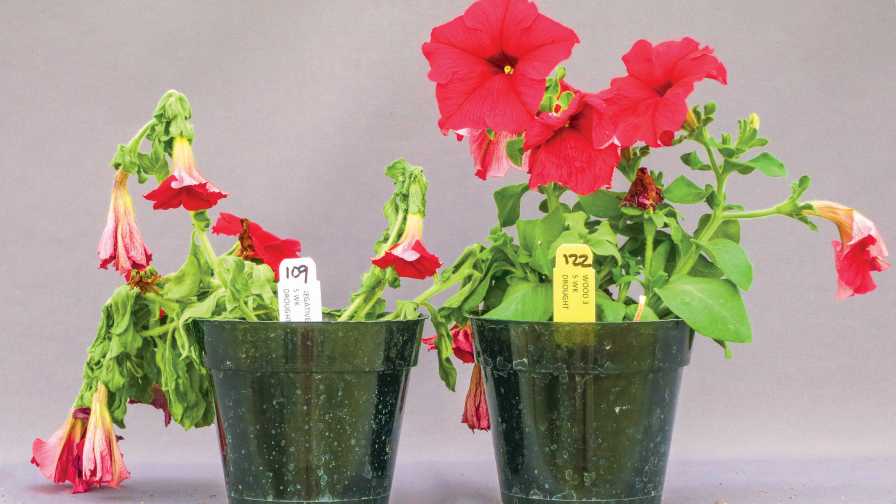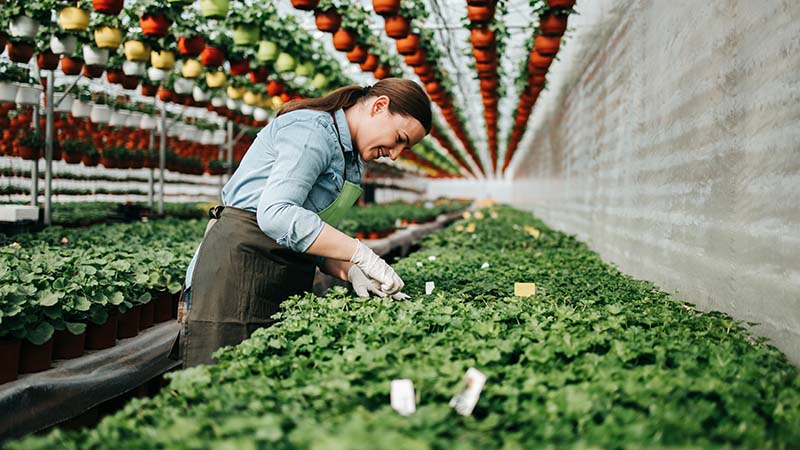How Biostimulants Can Improve Quality in Ornamentals

Application of beneficial bacteria from an Ohio State University collection increases drought stress tolerance of Petunia × hybrida. Plants were not irrigated for five days. Plants on the right were treated weekly with Pseudomonas brassicacearum Wood3 and plants on the left were untreated. Treatment with beneficial bacteria delayed visual symptoms of wilting and increased recovery rates once stressed plants were rewatered. Photo: Laura Chapin (OSU)
Chances are you’ve heard of biostimulants. This relatively new category of products has gotten a lot of attention from outdoor fruit and vegetable growers, but adoption in the greenhouse has been limited to this point. Here’s a look at how these products might fit in your greenhouse ornamentals production.
What Are Biostimulants?
Biostimulants are a diverse group of sustainable products that can increase overall plant health and crop quality by promoting growth and enhancing environmental (i.e., abiotic) stress tolerance. The 2018 Farm Bill defines a plant biostimulant as “a substance or micro-organism that, when applied to seeds, plants, or the rhizosphere, stimulates natural processes to enhance or benefit nutrient uptake, nutrient use efficiency, tolerance to abiotic stress, or crop quality and yield.”
The EPA currently does not regulate biostimulant products, but it is considering whether the plant growth responses of biostimulants should fall under plant growth regulator claims. A result of this decision may lead to regulation of some plant biostimulant products as pesticides under FIFRA (the Federal Insecticide, Fungicide, and Rodenticide Act). We will have to stay tuned for further information on these possible changes.
What Are the Active Ingredients in Biostimulant Products?
The definition of a biostimulant product, and what ingredients contribute to positive plant growth responses, may be somewhat ambiguous. Additionally, biostimulant products may include a single active ingredient or combinations of various categories of active ingredients.
Active ingredient categories may include humic substances, protein hydrolysates, biopolymers, botanical extracts, and beneficial microorganisms. What is important is that the active ingredient stimulates natural processes in the plant that lead to growth promotion by enhancing nutrient uptake or nutrient use efficiency. Biostimulant products may also stimulate any number of metabolic processes in plants that lead to increased tolerance of abiotic stresses. These products do not include macro or micronutrients, and biostimulants alone do not provide any nutritionally relevant fertilizer benefit.
How Can Biostimulants Improve Ornamental Crop Quality?
Plant biostimulant products provide natural and sustainable tools that can be used in conjunction with synthetic chemical inputs for overall plant health management. These products can improve crop quality at all stages of the production and marketing chain.
Increased yield in fruit and vegetable production is a more easily observable and measurable result. However, success can be a little more nebulous with ornamental plants. Biostimulants can increase the quality of ornamental crops through different mechanisms, resulting in a variety of benefits, such as: improved seedling vigor, greater shoot or root growth, greener leaves (i.e., increased chlorophyll content), increased flower numbers, larger flowers, and/or decreased time to flowering (i.e., decreased production timing).
While many products claim that they increase plant growth, an increase in vegetative growth can be at the expense of flowering, which is not a desirable outcome in flowering ornamentals. Therefore, it’s important to choose a biostimulant product that will stimulate plant growth appropriate for your specific crop and marketing criteria.
A potential challenge of gauging success with biostimulant products is observing positive responses when plants are grown under optimal conditions (i.e., fertility, irrigation, low-pest pressure).
There are three major areas where biostimulants may have the greatest impact for the greenhouse industry:
- Plants can use both water and nutrients more efficiently, so inputs can be reduced while still producing high-quality plants. This can lead to cost savings from reduced fertilizer usage, reduced water usage, and reduced labor. There are also environmental benefits when nutrients are used more efficiently by the plant and less is lost to leaching.
- Plants are generally more resilient. This means that during production, shipping, and retailing, plants are more tolerant of abiotic stresses, including drought. Plants are more likely to recover, resume normal growth, and be sellable following periods of stress.
- Biostimulants help build a healthy microbiome (e.g., the microbial community in a particular environment). This is similar to what probiotics do for the human digestive system. We often give little regard to the root-associated microorganisms of containerized plants and the benefits they can have on plant growth and stress tolerance. Biostimulants can be part of a strategy to engineer a healthy microbiome by increasing diversity of beneficial microorganisms or improving the growing media environment to promote more beneficial plant-microbe interactions.
How Do I Choose a Plant Biostimulant?
Choosing a biostimulant can be overwhelming. To help growers select biostimulant products, The Ohio State University has created a biostimulant resource that includes commercial products with a growth promotion claim for vegetable, nursery, and greenhouse crops.
Whichever biostimulants you choose, test them in a small area before applying to your entire crop. This trialing will allow you to optimize application timing and rates and determine how your growing environment and other inputs will influence the growth responses that you observe in your crops. Other factors we suggest considering are:
- Have these products been tested in independent, third-party trials?
- Can the manufacturer or sales rep show you research results?
- How many and what types of plants have been evaluated?
- Has the product been shown to work on the plants you are growing?
- Has the product been shown to work on plants in soilless grow-ing mixes?
- Are there any potential phytotoxicities or incompatibilities with other products, including beneficials?
- What greenhouse environmental factors may influence the efficacy of the products?
Biostimulant products have great potential to reduce various chemical inputs without sacrificing plant growth or crop quality. However, with the introduction of any new product, it is vital to consider both the risks and the rewards. Biostimulants will not serve as a fix-all to growing issues but can act as an effective insurance policy. When implemented properly, biostimulants can serve as a great addition to your grower’s toolbox, resulting in higher quality plants, decreased costs, and a reduced environmental impact.
Funding support for this research comes from the OSU D.C. Kiplinger Endowment and the American Floral Endowment.










